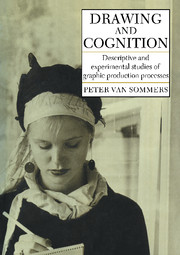Book contents
- Frontmatter
- Contents
- Preface
- 1 Basic executive constraints in drawing
- 2 Maintaining paper contact, anchoring, and planning
- 3 The reproduction of rectilinear figures
- 4 The production of curvilinear forms
- 5 The impact of meaning on executive strategies
- 6 Simple representational drawing
- 7 Difficult graphic tasks: A failure in perceptual analysis?
- 8 Stability and evolution in children's drawings
- 9 Innovations, primitives, contour, and space in children's drawings
- 10 Children's repeated drawings: How are innovations coded?
- 11 The pragmatics of everyday graphic production
- References
- Index
- Frontmatter
- Contents
- Preface
- 1 Basic executive constraints in drawing
- 2 Maintaining paper contact, anchoring, and planning
- 3 The reproduction of rectilinear figures
- 4 The production of curvilinear forms
- 5 The impact of meaning on executive strategies
- 6 Simple representational drawing
- 7 Difficult graphic tasks: A failure in perceptual analysis?
- 8 Stability and evolution in children's drawings
- 9 Innovations, primitives, contour, and space in children's drawings
- 10 Children's repeated drawings: How are innovations coded?
- 11 The pragmatics of everyday graphic production
- References
- Index
Summary
How should this book be characterized? First, it is a monograph on the principles of simple drawing: It takes the reader through those mechanisms and skills that characterize the performance of the child and adult who, without professional training, set out to draw or copy simple (and occasionally not so simple) objects and designs. Second, it is basically empirical rather than theoretical or speculative. It is based on the documentation not only of products, but of processes of production, using video recording and systematic analysis of structure and detail. Third, the philosophy is rationalist. That is, it attempts wherever possible to use the sense of why things are done the way they are. I believe we should be most suspicious of the concept of the convention, and in particular the “arbitrary convention” as an explanation of action. Even when drawers fail abysmally to achieve their goals, their efforts are usually orderly and purposeful at many levels.
A note about the characteristics of the subjects. They were all volunteers (or in the case of the small children, were volunteered), and in either case deserve my thanks. Almost all the subjects, with the exception of a group of English left-handers studied in Cambridge (through the good offices of the Cambridge Public Library) and some people whose native scripts and calligraphy were studied (Chinese, Thai, Burmese, Arabic, Hebrew), were part of the Australian population, more specifically the Sydney population.
- Type
- Chapter
- Information
- Drawing and CognitionDescriptive and Experimental Studies of Graphic Production Processes, pp. xi - xiiPublisher: Cambridge University PressPrint publication year: 1984



